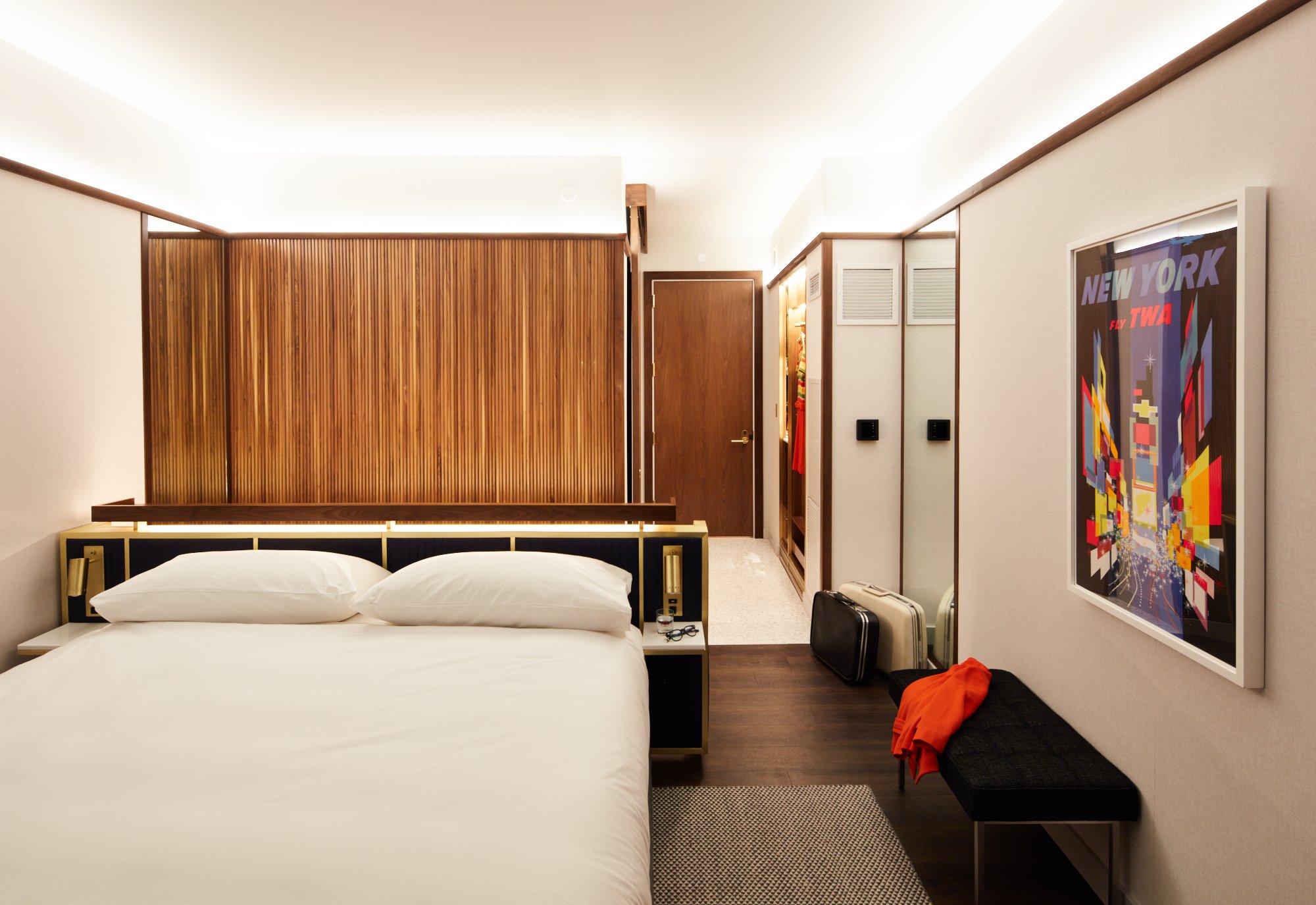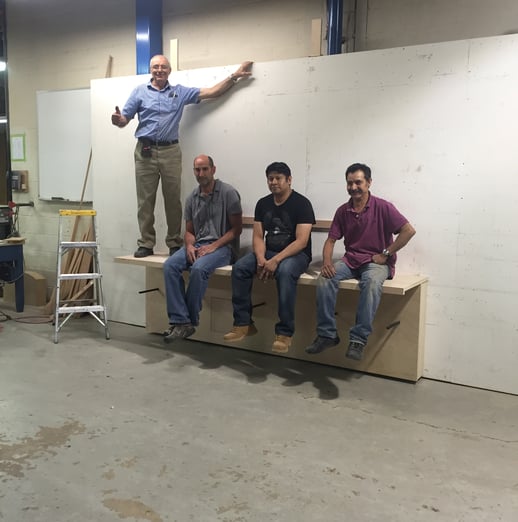What does quality furniture design really mean? To find out the answer, we sought two accomplished professionals to share their experience as they distinguish furniture of the highest quality. First, we spoke to Sylvie Blondeau AIA, LEED GA; Project Manager with MCR Investors, which just debuted the incredible new TWA Hotel at JFK, and Samuelson Furniture’s in-house design expert Mike Rinaldi.
Here’s how they approach great furniture design:
Sylvie Blondeau AIA, LEED GA; Project Manager, MCR Investors
How long do you expect hospitality furniture to last?
I expect it to last between 5 to 8 years, but I would really love 10 to 12 years. However, by that age most furniture is no longer in very good condition.
How do you assure the furniture you are buying will last?
You must trust the fabricators to help with the longevity, understanding that, if necessary, at some point an item can be refurbished.
When renewing a hotel’s furniture, do you have a go-to vendor list? What are the criteria to make it onto that list?
We don’t have a specific list per se, but we have a myriad of vendor connections and always look to the purchasing agent to guide us to the right source for the right design at the right price point.
This is a very busy time, so one must always look at new people. The purchasing agent is a great resource for this. During the construction of the TWA Hotel, for example, we selected Samuelson Furniture because they’re tried and true and great at what they do. This opportunity provided us with a new vendor with whom we developed a great relationship. All their furniture is very well built, and we expect it to last 10 years or longer.

TWA Hotel - MCR owned- Guestroom design by Stonehill & Taylor - Purchased by Parker International – photo credit David Mitchell
In what ways do you rely on your vendor for product overview?
It’s very critical to rely on vendors to ensure high quality product. They’re the ones seeing and/or operating the factory, which I rarely have an opportunity to observe. I rely on vendors for certification, to guide me and act as quality control assurance, scheduling and more.
If there is a problem we must address, Samuelson’s team is strategically helpful to troubleshoot quickly and keep the project on time and on budget. Samuelson is great in that regard. They are very active and offer solutions very quickly when needed. They’re 100% helpful.
What did you have to learn the hard way when purchasing product for hotels?
Construction is not a scientific process, so even with all contingency planning in the world, it’s never perfect. My rule is to always have a plan B. Always have more plan B’s in place.
What is the biggest difference between working on an airport hotel vs a boutique or resort location?
I’d say that airport hotels would need much more robust specs than a boutique hotel. Airport clientele is more transient. As they will not consider their guestroom as their home away from home, they will be rougher on the furniture. In such a case, I am looking for specifications that emphasize durability and allow for graceful patina to alleviate the wear and tear.
Both the designer and the fabricator would need to ensure this need is met.
Mike Rinaldi, In-House Designer with Samuelson Furniture
How do you create quality furniture while maintaining design intent within budget?
It’s our goal to bring the client’s entire vision to life. That being said, there are times during the engineering process that we have to make changes. These changes are really important to improve stability and longevity. You just have to be mindful of how these might affect the cost and appearance. Many times just adding a bit of overall thickness or moving some structure around can satisfy a requirement, without altering the overall design.
What are the most needed and most under spec'd details in furniture design?
It’s the extras. Fridge specs, TV’s, Lighting, outlet locations, etc. These things all dictate the initial layout of the furniture.
What are the most important details to remember when designing custom furniture for hotels?
Scale, functionality, & safety
Are there any design details that hotels don't want to pay for, or should add to ensure higher quality furniture?Yes, starting with the hardware. Under mount drawer slides, which look cleaner and work more smoothly, tend to be a bit more expensive than the standard side mounts. Solid stone and glass tops are sometimes on the chopping block despite their excellent durability when used on working surfaces. From the aesthetic standpoint, exotic veneers can also drive up the cost.
What three things do you always include in your furniture designs to help it last longer?
First would be the connection points. Insuring that where joints & materials meet up they will remain tight and continue to look great over time despite constant use and different climates. Next would be adding the proper hardware. Using the right slides, hinges, & connectors will insure the furniture functions properly over the long haul. Last but very important would be strength. If the furniture hangs on a wall or has a large open area between components we have to add whatever structure needed to make sure it doesn’t warp or fail even under crazy circumstances.
 We test everything to make sure it is safe for all unforeseen circumstances
We test everything to make sure it is safe for all unforeseen circumstances
What species of wood are the best to ensure high quality in furniture?
Most woods, if used properly, can create a quality piece of furniture. Some of the popular ones include Walnut, Oak, and Maple, just to name a few. Each one has its own characteristics. And the ultimate choice is normally influenced by whatever finish is selected.
How can you tell quality furniture just by looking?
I think it’s difficult. You have to get closer and put your hands on it. Turn it upside down and look underneath. Most furniture can look pretty good at first glance. It’s when you operate the doors and drawers or with seating…simply sit in it…that the quality shows.
What should designers be looking at when checking their model rooms and comparing vendors?
Since the finish makes the first impression, the most important thing is to compare it to the approved sample. Check to see if the finish is applied evenly and is sharp at the transition points. If the wood grain plays a prominent role, then how thoughtful was the vendor when arranging it? Interpretation is next. Does the model reflect what was approved? Any deviation without a good reason and proper heads up can make or break a vendor’s chances. Going back to quality, operate all of the moving parts, check the interiors, & lean on it as we say.
Working with an experienced furniture manufacturer who has both design and engineering insight will provide assurance throughout the entire process. The final product must be built to last while achieving both the design and owner’s vision.
Learn how to spot and spec the attributes of fine quality furniture in our whitepaper series part 6 First Impressions Built To Last

